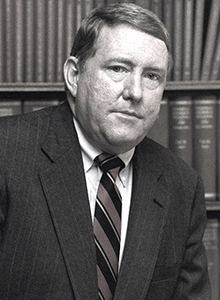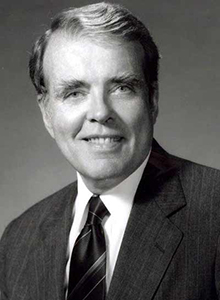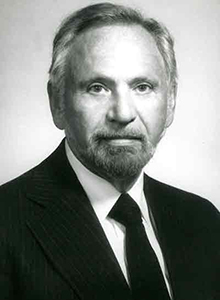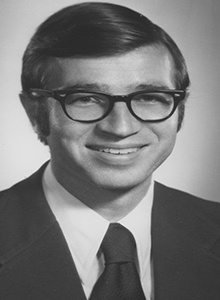
E. Gerald Corrigan
- President, Federal Reserve Bank of New York, 1985–1993
- President, Federal Reserve Bank of Minneapolis, 1980–1984
- Born: June 13, 1941
- Died: May 17, 2022
E. Gerald Corrigan served the Federal Reserve System for nearly 25 years as president of the Federal Reserve Banks of Minneapolis (August 1, 1980—December 31, 1984) and of New York (January 1, 1985—July 19, 1993).
Corrigan was born in Waterbury, Connecticut, in 1941. He earned a bachelor's degree in economics from Fairfield University in 1963 and his master's (1965) and his doctorate (1971) in economics from Fordham University.1
He began his career with the Federal Reserve System in 1968, when he joined the Federal Reserve Bank of New York as an economist. He continued his career at the New York Fed, working in various official positions, until 1979 when he took a leave of absence to serve as special assistant to then-Chairman Paul Volcker at the Board of Governors of the Federal Reserve System in Washington, DC. While there, he was named chairman of the Basel Committee on Banking Supervision by the governors of the central banks of the Group of Ten countries.2
On August 1, 1980, Corrigan took office as the 10th president of the Federal Reserve Bank of Minneapolis. During his four-year tenure as president, a major change in the nation’s banking system occurred with the passage of the 1980 Depository Institutions Deregulation and Monetary Control Act. To comply with this act, the Federal Reserve had to price its financial services, establish reserve requirements for all eligible financial institutions and offer financial services to all depository institutions. Corrigan wrote extensively about what this meant to financial institutions and to the Federal Reserve System.3
Corrigan returned to the New York Fed on January 1, 1985, to serve as president.4 Corrigan had a specific vision for the New York Fed, saying that the Reserve Bank was not just about "what we are, but [about] what we can be." Though he agreed that the New York Fed is "perhaps a bit mysterious and certainly is imposing … there cannot be, either to us [the Federal Reserve System] or to bankers, an imaginary fence around our Florentine structure on Liberty Street."5 He led the New York Fed through the stock market crash of October 1987 when the financial markets experienced record-breaking declines.6 He was also instrumental in steering the Reserve Bank through what came to be known as the Drexel Burnham Lambert scandal7 in 1989.8
Corrigan stepped down as president of the New York Fed on July 19, 1993. He joined investment firm Goldman Sachs as a partner in 1994.9
Corrigan died in 2022.1
Endnotes
- 1 Jon Hilsenrath and James Hagerty. "Gerald Corrigan Led New York Fed During Wall Street Turmoil." Wall Street Journal, May 20, 2022.
- 2 "E Gerald Corrigan," Biographical information from the Federal Reserve Bank of New York, n.d.
- 3 Federal Reserve Bank of Minneapolis. "E. Gerald Corrigan." n.d. See also, for instance, E. Gerald Corrigan and Evelyn F. Carroll. "Meeting the Challenges of a New Banking Era." Federal Reserve Bank of Minneapolis Annual Report 1981.
- 4 John M. Berry. "Corrigan Named to Head N.Y. Federal Reserve Bank." Washington Post, September 22, 1984.
- 5 "E. Gerald Corrigan Discusses the Role of Our Bank, Bank Deregulation, and the Economy." The Fed, March 1985.
- 6 Bob Woodward. "In '87 Crash, All Eyes on Greenspan." Washington Post, November 13, 2000. Michael Quint. "The Fed's Plumber: E. Gerald Corrigan; A Crisis Manager Takes on the Mechanisms of the Market." New York Times, October 2, 1988.
- 7 E. Gerald Corrigan, interview by David H. Small and Jeffrey Ernsthausen. Federal Reserve Board Oral History Project, July 14, 2009; November 18, 2009; and March 24, 2010.
- 8 Kurt Eichenwald. "The Collapse of Drexel Burnham Lambert; Drexel, Symbol of Wall St. Era, Is Dismantling; Bankruptcy Filed." New York Times, February 14, 1990.
- 9 While at Goldman Sachs, Corrigan began dating and later married then-Boston Fed president Cathy Minehan. The two worked with lawyers at both the Federal Reserve and at Goldman Sachs to ensure that their personal relationship did not constitute a conflict of interest for either Goldman or the Fed. See Peter Truell. "A Fed Official's Romance Raises Issue of Conflict." New York Times, April 9, 1997.
Written by the Federal Reserve Bank of New York as of November 2013 and updated by Ella Needler, Lily Aydt, and Genevieve Podleski as of October 2022. See disclaimer and update policy.





